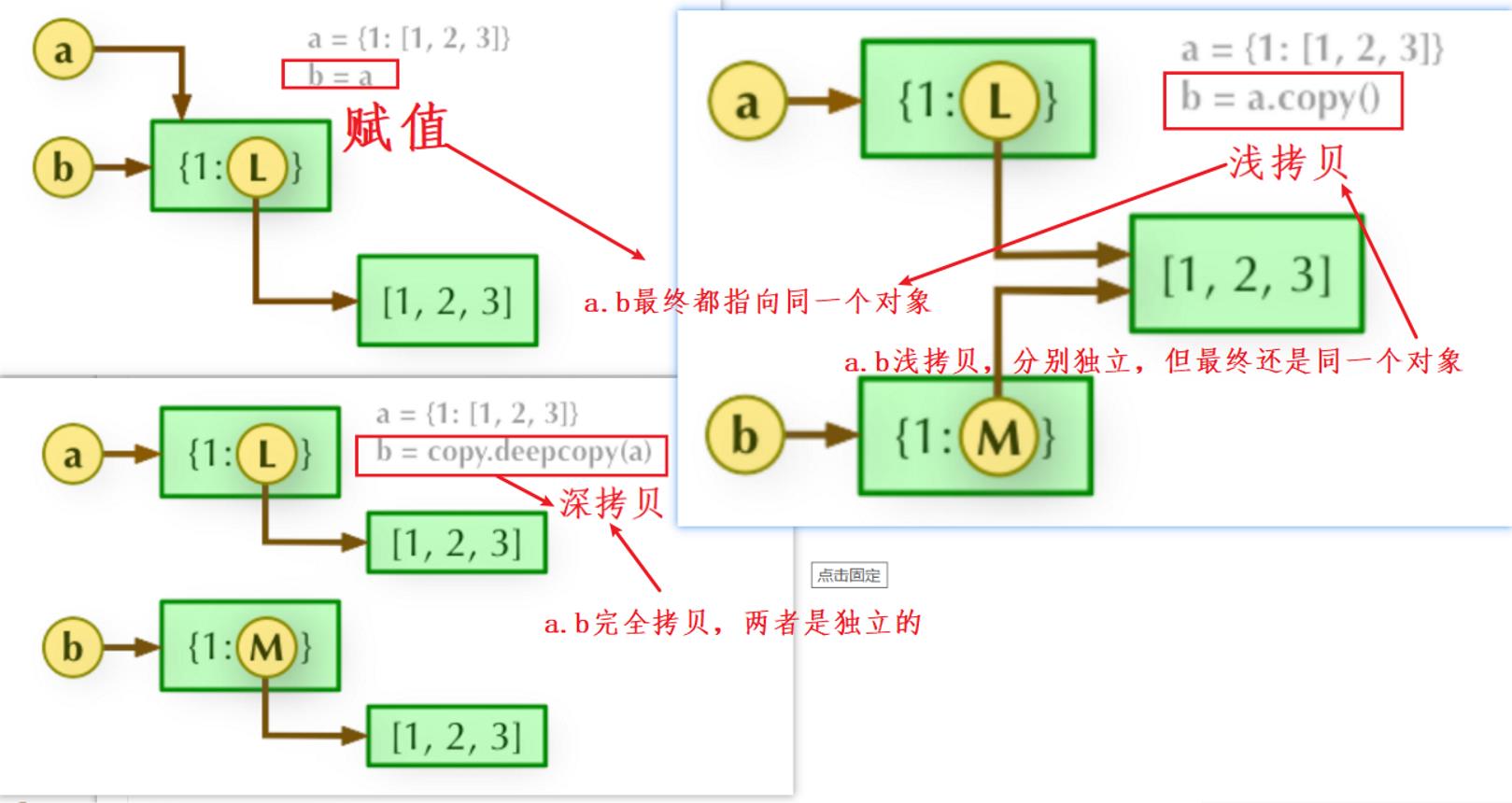Python 常用方法和模块的使用
Posted 折翼の翅膀
tags:
篇首语:本文由小常识网(cha138.com)小编为大家整理,主要介绍了Python 常用方法和模块的使用相关的知识,希望对你有一定的参考价值。
1 比较常用的一些方法
1.eval()方法:执行字符串表达式,并返回到字符串。
2.序列化:变量从内存中变成可存储或传输到文件或变量的过程,可以保存当时对象的状态,实现其生命周期的延长,并且需要时可以再次将这个对象读取出来.
涉及到2个方法:变量:dumps()、loads()和文件:dump()、load()
3.静态方法、类方法、属性方法
2 比较常用的一些模块
对应模块下如何查看对应的变量和方法:
模块名.__all__
help(模块名.变量/方法)
#查看对应模块下有哪些方法和变量
>>> random.__all__
[\'Random\', \'seed\', \'random\', \'uniform\', \'randint\', \'choice\', \'sample\', \'randrange\', \'shuffle\', \'normalvariate\', \'lognormvariate\', \'expovariate\', \'vonmisesvariate\', \'gammavariate\', \'triangular\', \'gauss\', \'betavariate\', \'paretovariate\', \'weibullvariate\', \'getstate\', \'setstate\', \'getrandbits\', \'choices\', \'SystemRandom\']
#查看对应模块的内容
>>> help(random.seed)
Help on method seed in module random:
seed(a=None, version=2) method of random.Random instance
Initialize internal state from hashable object.
None or no argument seeds from current time or from an operating
system specific randomness source if available.
If *a* is an int, all bits are used.
For version 2 (the default), all of the bits are used if *a* is a str,
bytes, or bytearray. For version 1 (provided for reproducing random
sequences from older versions of Python), the algorithm for str and
bytes generates a narrower range of seeds.
1.time 、datetime模块
通常有这三种方式来表示时间:时间戳、元组(struct_time)、格式化的时间字符串:
(1)时间戳(timestamp) :通常来说,时间戳表示的是从1970年1月1日00:00:00开始按秒计算的偏移量。我们运行“type(time.time())”,返回的是float类型。
(2)格式化的时间字符串(Format String):\'2019-11-13\',返回的是字符串类型。
(3)元组(struct_time) :struct_time元组共有9个元素共九个元素:(年,月,日,时,分,秒,一年中第几周,一年中第几天等),返回的是元组。
| 索引(Index) | 属性(Attribute) | 值(Values) |
|---|---|---|
| 0 | tm_year(年) | 比如2011 |
| 1 | tm_mon(月) | 1 - 12 |
| 2 | tm_mday(日) | 1 - 31 |
| 3 | tm_hour(时) | 0 - 23 |
| 4 | tm_min(分) | 0 - 59 |
| 5 | tm_sec(秒) | 0 - 60 |
| 6 | tm_wday(weekday) | 0 - 6(0表示周一) |
| 7 | tm_yday(一年中的第几天) | 1 - 366 |
| 8 | tm_isdst(是否是夏令时) | 默认为0 |
主要关系如下:

举例:
import time
t=time.time #获得时间戳
a=time.localtime(t) #获得当地时间的时间元组
b=time.gmtime(t)#获得格林威治时间的时间元组,有8个小时的时差
time.asctime(a) #获得时间的字符串
time.strftime(\'%Y-%m-%d %H:%M:%S\',a) #获得指定格式的本地时间
time.strptime(时间字符串,字符串对应格式) #获得时间元组
ex:
#获取时间戳
>>> time.time()
1573629408.9401257
#时间戳--->元组时间
>>> time.gmtime(time.time())
time.struct_time(tm_year=2019, tm_mon=11, tm_mday=13, tm_hour=7, tm_min=17, tm_sec=35, tm_wday=2, tm_yday=317, tm_isdst=0)
>>> time.localtime(time.time())
time.struct_time(tm_year=2019, tm_mon=11, tm_mday=13, tm_hour=15, tm_min=17, tm_sec=8, tm_wday=2, tm_yday=317, tm_isdst=0)
#元组时间--->时间戳
>>> time.mktime(time.localtime(time.time()))
1573628709.0
#元组时间 --->格式化时间
>>> time.asctime(time.localtime(time.time()))
\'Wed Nov 13 15:19:04 2019\'
>>> time.ctime()
\'Wed Nov 13 15:24:26 2019\'
>>> time.strftime(\'%Y-%m-%d\',time.localtime(time.time()))
\'2019-11-13\'
#格式化时间---> 元组时间
#time.strptime(时间字符串,字符串对应格式)
>>> time.strptime(\'2019-11-13\',\'%Y-%m-%d\')
time.struct_time(tm_year=2019, tm_mon=11, tm_mday=13, tm_hour=0, tm_min=0, tm_sec=0, tm_wday=2, tm_yday=317, tm_isdst=-1)
>>> time.ctime()
\'Wed Nov 13 15:24:26 2019\'
参考如下:
https://www.runoob.com/python3/python3-date-time.html
https://docs.python.org/3/library/time.html
2.random
#random()方法返回随机生成的一个实数,在[0,1)范围内
>>> import random
>>> random.random()
0.9769965303661935
#uniform()随机生成0-20之间的浮点数
>>> random.uniform(0,20)
1.3427421915969069
>>> random.uniform(0,20)
1.302763489201494
#randint()方法随机生成1-3之间的整数
>>> random.randint(1,3)
2
#randrange()方法随机生成0-100之间的偶数,步长为2
>>> random.randrange(0,100,2)
14
#对序列随机选择一个元素
>>> random.choice(\'改变世界\')
\'界\'
>>> random.choice(\'改变世界\')
\'改\'
>>> random.choice([\'sumshine\',\'is\',\'lower\']) #对列表选择一个元素
\'sumshine\'
>>> random.choice([\'sumshine\',\'is\',\'lower\'])
\'is\'
>>> random.choice((\'sumshine\',\'is\',\'lower\')) #对元组选择一个元素
\'is\'
#对列表元素随机排序
>>> list=[1,2,3]
>>> random.shuffle(list)
>>> list
[1, 3, 2]
3.os
os.listdir() 方法用于返回指定的文件夹包含的文件或文件夹的名字的列表。一般与for循环结合使用。
import os
def start_running():
Print(\'-----接口自动化执行开始-----\')
#测试报告数据清除
Try:
For one in os.listdir(\'../report/tmp\'):
If \'json\' in one or \'txt\' in one:
os.remove(\'../report/tmp/{one}\')
Except:
Print(\'-----第一次执行pytest框架-----\')
>>> os.__all__
[\'altsep\', \'curdir\', \'pardir\', \'sep\', \'pathsep\', \'linesep\', \'defpath\', \'name\', \'path\', \'devnull\', \'SEEK_SET\', \'SEEK_CUR\', \'SEEK_END\', \'fsencode\', \'fsdecode\', \'get_exec_path\', \'fdopen\', \'popen\', \'extsep\', \'_exit\', \'DirEntry\', \'F_OK\', \'O_APPEND\', \'O_BINARY\', \'O_CREAT\', \'O_EXCL\', \'O_NOINHERIT\', \'O_RANDOM\', \'O_RDONLY\', \'O_RDWR\', \'O_SEQUENTIAL\', \'O_SHORT_LIVED\', \'O_TEMPORARY\', \'O_TEXT\', \'O_TRUNC\', \'O_WRONLY\', \'P_DETACH\', \'P_NOWAIT\', \'P_NOWAITO\', \'P_OVERLAY\', \'P_WAIT\', \'R_OK\', \'TMP_MAX\', \'W_OK\', \'X_OK\', \'abort\', \'access\', \'chdir\', \'chmod\', \'close\', \'closerange\', \'cpu_count\', \'device_encoding\', \'dup\', \'dup2\', \'environ\', \'error\', \'execv\', \'execve\', \'fspath\', \'fstat\', \'fsync\', \'ftruncate\', \'get_handle_inheritable\', \'get_inheritable\', \'get_terminal_size\', \'getcwd\', \'getcwdb\', \'getlogin\', \'getpid\', \'getppid\', \'isatty\', \'kill\', \'link\', \'listdir\', \'lseek\', \'lstat\', \'mkdir\', \'open\', \'pipe\', \'putenv\', \'read\', \'readlink\', \'remove\', \'rename\', \'replace\', \'rmdir\', \'scandir\', \'set_handle_inheritable\', \'set_inheritable\', \'spawnv\', \'spawnve\', \'startfile\', \'stat\', \'stat_result\', \'statvfs_result\', \'strerror\', \'symlink\', \'system\', \'terminal_size\', \'times\', \'times_result\', \'truncate\', \'umask\', \'uname_result\', \'unlink\', \'urandom\', \'utime\', \'waitpid\', \'write\', \'makedirs\', \'removedirs\', \'renames\', \'walk\', \'execl\', \'execle\', \'execlp\', \'execlpe\', \'execvp\', \'execvpe\', \'getenv\', \'supports_bytes_environ\', \'spawnl\', \'spawnle\'
4.sys & shutil
shutil主要作用与拷贝文件用的.
shutil.copyfileobj(文件1,文件2):将文件1的数据覆盖copy给文件2。
shutil.copyfile(文件1,文件2):不用打开文件,直接用文件名进行覆盖copy。
shutil.copymode(文件1,文件2):之拷贝权限,内容组,用户,均不变。
shutil.copystat(文件1,文件):只拷贝了权限。
参考博文:https://www.cnblogs.com/xiangsikai/p/7787101.html
5.shelve
shelve模块 也可以序列化Python所有数据类型,而且可以多次序列化;shelve模块通过key-value方式持久化
参考博文:https://www.cnblogs.com/bert227/p/9324591.html
6.xml处理
参考博文:https://www.cnblogs.com/ginvip/p/6891534.html
https://www.runoob.com/python/python-xml.html
7.configparser
参考博文:https://www.cnblogs.com/ming5218/p/7965973.html
8.copy的用法
参考博文:https://www.runoob.com/w3cnote/python-understanding-dict-copy-shallow-or-deep.html
-
直接赋值:其实就是对象的引用(别名)。
-
浅拷贝(copy):拷贝父对象,不会拷贝对象的内部的子对象。
-
深拷贝(deepcopy): copy 模块的 deepcopy 方法,完全拷贝了父对象及其子对象。

3、python常用注意点
3.1 python在不同层级目录import模块的方法:一般有2种方式,通过sys.path.append("路径")和在目录中添加__init__.py文件。
参考文章:https://www.cnblogs.com/kex1n/p/5971590.html
3.2 python 接口测试-使用requests模块发送GET请求:有参数、无参数、带header参数
参考文章:https://www.cnblogs.com/feiyueNotes/p/7857784.html
以上是关于Python 常用方法和模块的使用的主要内容,如果未能解决你的问题,请参考以下文章